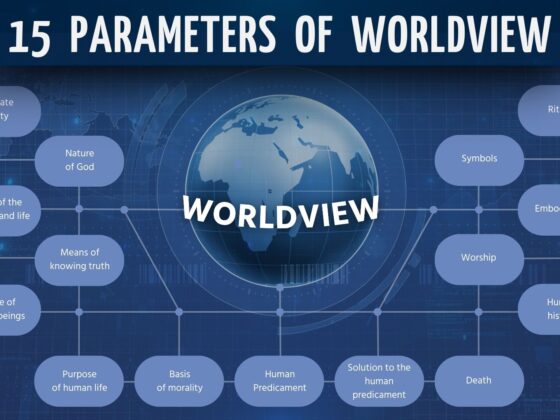What Is the 3-D Worldview Survey?
January 31, 2023
Katherine Schultz
Let’s start with a question: Why even try to assess worldview? The Bible encourages us to be reflective.
Test yourselves to see if you are in the faith; examine yourselves! Or do you not recognize this about yourselves, that Jesus Christ is in you-unless indeed you fail the test? (2 Cor 13:5, NASB)
While a survey will only give a partial view of a person’s worldview, it can help reveal areas to grow, as well as be an encouragement of how a person has matured in his or her worldview and faith. When used as part of a more complete personal reflection, surveys can be a helpful tool for seeing our own biblical worldview maturity more clearly.
About the 3DWS
The 3-Dimensional Worldview Survey (3DWS) is designed for use with students in middle school or older. By this age, students’ understanding of the world is beginning to form and they can think about their beliefs and communicate it clearly. Ideally, they are also young enough that their future goals and intentions are still developing. The Flesch-Kincaid Grade Level for the instrument is 7.3, so the survey is at an appropriate level for a general audience, and does not contain highly technical vocabulary.
Format
The 3DWS is an electronic survey (mobile or desktop) to understand a person’s biblical worldview. It can be completed within a standard class period of 45 minutes, though the average time is actually about 15 minutes.
The idea of a 3-dimensional worldview comes from James Sire’s (2004) definition in Naming the Elephant: “A worldview is a commitment, a fundamental orientation of the heart, that can be expressed as a story or in a set of presuppositions (assumptions which may be true, partially true, or entirely false) which we hold (consciously or subconsciously, consistently or inconsistently) about the basic constitution of reality, and that provides the foundation on which we live and move and have our being.” (Sire, 2004, 122)
Components
The 3 dimensions are propositional (beliefs), behavioral, and heart-orientation (attitudes). The propositional dimension is the presuppositional or assumption dimension of worldview: what a person thinks, knows, or believes to be true. The behavioral dimension of worldview is that which a person does: the “live and move” of every day. The definition of heart in use for this study is “the religious, intellectual, affective, and volitional center of a person” (Naugle, 2002, 270). It is the attitudes and intentions, the inner thoughts, with which a person does everything. The items in the survey relate to a wide variety of topics in the propositional, behavioral, and heart-orientation dimensions.
The propositional items in the survey cover a range of topics to touch as many aspects of a person’s worldview as possible. Topics include history, hermeneutics, morality, and theology. The behavioral items in the survey ask about behaviors in church, and in the wider community. They also ask students to answer questions about activities like a person’s thinking that could only be ascertained by self-disclosure. Questions about the heart-orientation dimension cover things like the person’s attitudes, feelings, and preferences.
Question Types
The survey uses multiple choice questions with responses of three types: level of agreement (Strongly Disagree, Disagree, Neutral, Agree, Strongly Agree); general frequency (Very Rarely, Rarely, Occasionally, Frequently, Very Frequently); or specific frequency (about 10 hours or less a year, about 1-2 hours a month, about 1 hour a week, about 15-30 minutes a day, more than 30 minutes a day). You can see 3 of the 3DWS questions if you are interested, or you can grab the free pdf, “10 Questions to help understand someone’s worldview” for more.
Using the 3DWS
Individuals can complete the survey and pay online at the link HERE.
Groups of more than 10 have two options: you can register a group and receive an invoice due when score reports are sent, or you can register a group and have individual group members pay. Both group options will need a group code for the survey in order to assure accurate group membership and reporting. Register your group and get your group code by emailing us if you are ready to do that now. Or you can grab a sample of 10 questions from the survey in the PDF below.
3DWS Results Reporting
An individual 3DWS score report shows a radar graph, with subscore and composite numerical scores, as well as explanations and comments relevant to the results. The minimum score for each dimension is 19, and the maximum score for each dimension is 96. The minimum composite score is 57, and the maximum composite score is 288. In addition, the report includes comments indicating inconsistencies between the dimensions. Finally, the report gives suggestions to help the student identify areas of potential growth.
For groups of 10 or more students, a summary report is available. It includes composite and subscore distributions; composite and subscore averages; and a summary report of individual composite, subscore, and brief descriptive results for each student.
Individual question response reports are also available.
Statistical Validity
The 3DWS was submitted to a panel of 11 experts for their evaluation of its clarity and relevance to the three-dimensional definition of worldview in use for this study. The purpose of the review was to determine the content validity of the individual items on the instrument as a measure of biblical worldview. These experts represent a variety of demographics and backgrounds:
- Sex: 6 men, 5 women
- Professional training: 6 theology, 7 education, 5 ministry, 2 other fields
- Professional experience: 5 theology, 8 education, 7 ministry, 3 other fields
- Avocational interests: 7 theology, 3 education, 6 ministry
- Education: 3 master’s degrees, 5 some postgraduate coursework, 1 doctorate
- Experience in education: 1 11-20 years, 5 21-30 years, 5 31-40 years of experience.
- Confessional faith: All experts were confessing Christians
- Denominational affiliations: 1 Assembly of God, 2 Baptist, 2 Lutheran, 1 nondenominational, 1 Presbyterian, 1 Seventh-Day Adventist
- Geographical locations: in the US, California, Minnesota, Virginia, and Texas; included several people who had extensive experience outside the country (including long-term missionaries and dual citizens), but specific information might have compromised the anonymity of particular respondents, so was not collected.
Based on the expert panel review, the 3DWS is statistically valid.
- The mean score for clarity on all items was 4.55 (SD=.835, N=883).
- The mean score for relevance on all items was 4.52 (SD=1.003, N=880).
Statistical Reliability
The instrument uses a Likert-scale item design because of its demonstrated reliability in survey research (Creswell, 2002, 172). The internal reliability for the 3DWS was evaluated using Cronbach’s alpha.
- For the 3DWS, Cronbach’s alpha was .923
This exceeds the target of .70 established in the research design based on Litwin (2003, 29). All three subscales also show good internal reliability. For a full description of the validity and reliability of the 3DWS, please see the article by Schultz & Swezey (2013) or the dissertation by Schultz (2012) noted in the references.
References
Creswell, J. W. (2002). Educational research: Planning, conducting, and evaluating quantitative and qualitative research. Upper Saddle River, NJ: Merrill Prentice Hall.
Holy Bible: New American Standard Bible. (1995, 2020). The Lockman Foundation. Retrieved 01 23, 2023, from https://www.biblegateway.com
Litwin, M. S. (2003). How to assess and interpret survey psychometrics (A. Fink, Ed.; 2nd ed.). Thousand Oaks, CA: Sage Publications.
Naugle, D. K. (2002). Worldview: The History of a Concept. Eerdmans Publishing Company.
Schultz, K. G. (2012). Developing an instrument for assessing student biblical worldview in Christian K-12 education. [Doctoral dissertation]. Available from ProQuest Dissertations and Theses database. (UMI No. 3534997).
Schultz, K. G., & Swezey, J. A. (2013, September). A Three-Dimensional Concept of Worldview. Journal of Research on Christian Education, 22(3), 227-243. 10.1080/10656219.2013.850612
Sire, J. W. (2004). Naming the Elephant: Worldview as a Concept. InterVarsity Press.





